
The Matterhorn is a mountain of the Alps, straddling the main watershed and border between Italy and Switzerland. It is a large, near-symmetric pyramidal peak in the extended Monte Rosa area of the Pennine Alps, whose summit is 4,478 metres (14,692 ft) above sea level, making it one of the highest summits in the Alps and Europe. The four steep faces, rising above the surrounding glaciers, face the four compass points and are split by the Hörnli, Furggen, Leone/Lion, and Zmutt ridges. The mountain overlooks the Swiss town of Zermatt, in the canton of Valais, to the northeast; and the Italian town of Breuil-Cervinia in the Aosta Valley to the south. Just east of the Matterhorn is Theodul Pass, the main passage between the two valleys on its north and south sides, which has been a trade route since the Roman Era.

The Dent Blanche is a mountain in the Pennine Alps, lying in the canton of Valais in Switzerland. At 4,357 m (14,295 ft)-high, it is one of the highest peaks in the Alps.
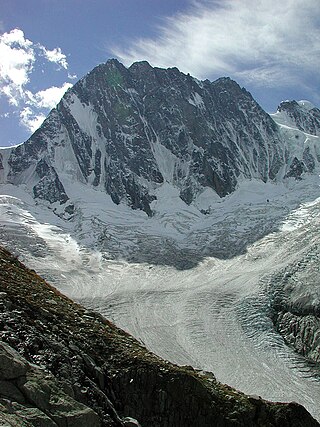
The Grandes Jorasses is a mountain in the Mont Blanc massif, on the boundary between Haute-Savoie in France and Aosta Valley in Italy.

Valtournenche is a town and comune in the Aosta Valley region of north-western Italy, 1,500 m (4,900 ft) above the sea level. It is named after and covers the upper side of the Valtournenche, a valley on the left side of the Dora Baltea, from Châtillon to the Matterhorn. Valtournenche municipality includes Breuil-Cervinia, whose ski resort is linked to Zermatt, Switzerland.

Breuil-Cervinia, officially Le Breuil from September 2023, is a frazione of the comune of Valtournenche, Italy. It is considered one of the most renowned winter and summer tourist resorts in the Alps.
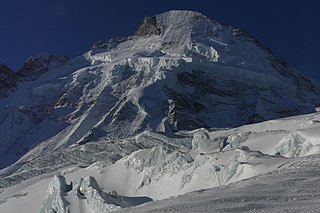
The Dent d'Hérens is a mountain in the Pennine Alps, lying on the border between Italy and Switzerland. The mountain lies a few kilometres west of the Matterhorn.

Mont Maudit is a mountain in the Mont Blanc massif in France and Italy. The French name literally means "Cursed Mountain". Until the end of the 18th century, Mont Blanc and its satellite peaks were collectively known in French as the Montagne Maudite.

Michel Auguste Croz was a Chamoniard mountain guide of the Kingdom of Sardinia and the first ascentionist of many mountains in the western Alps during the golden age of alpinism. He is chiefly remembered for his death on the first ascent of the Matterhorn and for his climbing partnership with Edward Whymper.

Jean-Antoine Carrel was an Italian mountain climber and guide. He had made climbs with Edward Whymper and was his rival when he attempted to climb the Matterhorn for the first time. Whymper ultimately succeeded in making the mountain's first ascent in July 1865 while Carrel led the party that achieved the second ascent three days later. Carrel was in the group that became the first Europeans to reach the summit of Chimborazo in 1880. He died from exhaustion when guiding a party on the south side of the Matterhorn.

The Dents de Bouquetins or just the Bouquetins are a multi-summited mountain of the Alps between Switzerland and Italy. They form a ridge composed of several summits above 3,600 metres, of which the highest is 3,838 metres. The Bouquetins are the highest mountain on the main watershed of the Pennine Alps west of the Dent d'Hérens.

The Hörnli Hut is a mountain hut located at the foot of the north-eastern ridge of the Matterhorn. It is situated at 3,260 metres (10,700 ft) above sea level, a few kilometres south-west of the town of Zermatt in the canton of Valais in Switzerland. It is also known as Berghaus Matterhorn.
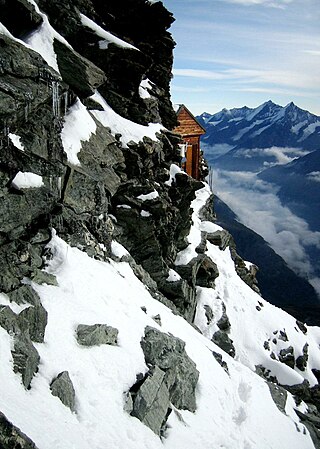
The Solvay Hut or Solvay Bivouac is a mountain hut located on the north-eastern ridge of the Matterhorn, near Zermatt in the canton of Valais. At 4,003 metres (13,133 ft) it is the highest mountain hut owned by the Swiss Alpine Club, but can be used only in case of emergency. The Hörnli Hut, lying 700 meters below on the same ridge, is the starting point of the normal route to the summit.
Luigi "Louis" Carrel, also known as Carrellino was an Italian mountain climber, mountain guide and ski mountaineer.
The Mountain Calls is a film directed by Luis Trenker which recreates the struggle between Edward Whymper and Jean-Antoine Carrel for the first successful ascent of the Matterhorn in 1865.
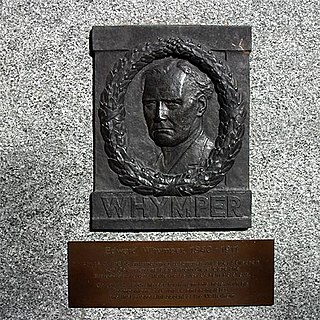
The first ascent of the Matterhorn was a mountaineering expedition made by Edward Whymper, Lord Francis Douglas, Charles Hudson, Douglas Hadow, Michel Croz, and two Zermatt guides, Peter Taugwalder and his son of the same name, on 14 July 1865. Douglas, Hudson, Hadow and Croz were killed on the descent when Hadow slipped and pulled the other three with him down the north face. Whymper and the Taugwalder guides, who survived, were later accused of having cut the rope below to ensure that they were not dragged down with the others, but the subsequent inquiry found no evidence of this and they were acquitted.
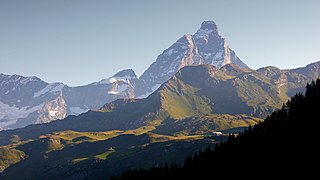
The second ascent of the Matterhorn was accomplished in July 1865, only three days after the successful expedition led by Edward Whymper on the Zermatt side. The second was effected on the Italian side by Jean-Antoine Carrel and Jean-Baptiste Bich with the abbé Amé Gorret and Jean-Augustin Meynet who followed them near to the summit. The party started from Breuil on 16 July and reached the top the following day.

Struggle for the Matterhorn is a 1928 German-Swiss silent drama film co-directed by Mario Bonnard and Nunzio Malasomma and starring Luis Trenker, Marcella Albani, and Alexandra Schmitt. The film is part of the popular cycle of mountain films of the 1920s and 1930s. Art direction was by Heinrich Richter. Trenker later remade the film as The Challenge in 1938.
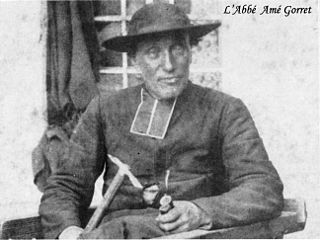
Amé Gorret (1836-1907), known in his native Aosta Valley as the "Abbé Gorret", was a priest and Alpinist (mountaineer).

The Goûter Hut, is a mountain refuge in the French department of Haute-Savoie. It is located at a height of 3,835 metres (12,582 ft) on the Arete du Goûter in the municipality of Saint-Gervais-les-Bains. It overlooks the Glacier de Bionnassay, and is the highest wardened mountain hut in France.

















